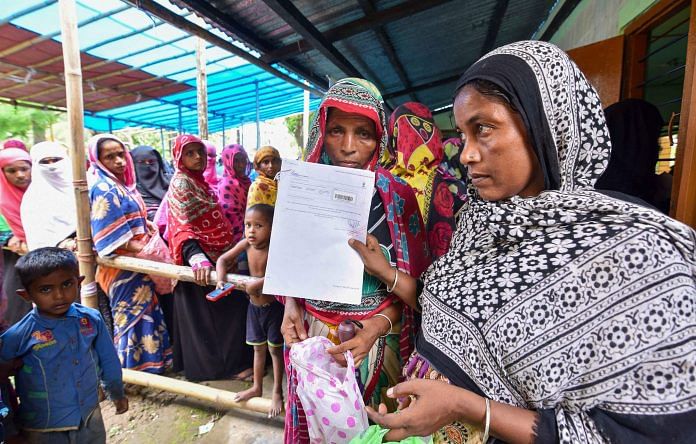New Delhi: With the Supreme Court extending the deadline for publishing the final National Register of Citizens (NRC) by a month, the spotlight is back on the detailed process that the contentious and complex exercise has entailed.
While the Centre and the Assam government had sought a ‘sample re-verification’ to ascertain if there were errors of inclusion and exclusion, NRC state coordinator Prateek Hajela requested for an extension of the 31 July deadline due to the devastating flood situation in the state.
On Tuesday, the apex court, while fixing 31 August as the new deadline, rejected the government’s plea for re-verification.
The NRC, first published after the 1951 Census, is now being updated in a Supreme Court-monitored exercise keeping 24 March 1971 as the cut-off to essentially identify those who immigrated to Assam illegally from Bangladesh after that date.
The NRC has been a socially and politically delicate issue in Assam, where ethnic fault-lines and the indigenous Assamese versus outsider debate has festered for decades.
The entire process of updating the list had been laid out with a step-wise approach, but this new demand for re-verification by the Modi government and the Sonowal dispensation has added to the confusion in what has already turned into a chaotic event.
ThePrint details the arguments around re-verification, the Centre and NRC coordinator’s contention and the various stages of this entire exercise.
Also read: ‘Fake’ complaints against genuine Indian citizens registered in NRC raises concern
The re-verification demand
The Centre and the state government demanded a sample re-verification of 20 per cent names in the districts bordering Bangladesh, and a 10 per cent re-verification in the remaining districts of Assam, claiming there may be errors of inclusion and exclusion.
Hajela, however, told the court that around 80 lakh names, or 27 per cent, were already re-verified during the ‘claims and objections’ process and hence, a separate exercise was not needed. The NRC office maintains that the percentage of those re-verified could, in fact, be even higher in border areas than the state average of 27 per cent.
Essentially, sample re-verification means picking names at random to check if the result that has been drawn about them — on whether they are genuine citizens or not — is correct, by checking legacy documents, family tree, etc.
To put it simply, re-verification seeks to decide if the eligibility determination has been correct or not.
However, the very purpose of including filing of claims and objections as a step after the publication of final draft in July last year was to ensure this verification, before coming out with final list. While claims for inclusion could be filed by any of those left out of the list, objections could be filed against the inclusion of any people included by any individual. Following these applications, an extensive hearings-based process was followed to verify.
The entire NRC exercise as laid down, therefore, has an in-built mechanism for automatic re-verification.
The obvious question to follow is if the Centre and the Assam government continue to be unsure about how watertight the exercise has been. If they fear errors, are they raising doubts about the final version of the list about to be published? And in that case, should the list be relied upon at all to determine if someone is an illegal immigrant given the process’ huge consequences?
The NRC process
The purpose of the process is to determine genuine Indian citizens in Assam from illegal immigrants.
It was the 1985 Assam Accord that demanded such an exercise be carried out in the state. However, it was following a PIL in September 2013 that the Supreme Court directed the Assam government to begin the exercise.
The process of receiving applications finally began in May 2015. The first draft of the list was released on 31 December 2017 and the final draft on 30 July last year. Of the total of 3.29 crore applicants, 2.9 crore found their names in the list. In June, an ‘additional draft exclusion list’ was published where one lakh names were dropped from the list.
The final list will be referred to the Foreigners Tribunal, and those left out can appeal to the courts. There is no clarity, however, on how those eventually left out and tagged as ‘foreigners’ would be dealt with, given the humanitarian and diplomatic import of the issue.
Also read: 48 ex-IAS officers urge Modi govt to fix NRC exercise, ‘ill-conceived’ Citizenship Bill







It is painful that the last stages of this exercise, which affects the fate of at least four million people, are being carried out at the height of the monsoon season, as Assam has been through one flood surge and is likely to receive one or two more. This is a rare instance where one is unable to applaud the initiative the apex court is taking.